Bill Gross warns on gold momentum as regional bank stocks tumble
Introduction & Market Context
Brandywine Realty Trust (NYSE:BDN) released its first quarter 2025 supplemental information package, revealing a strategic pivot toward life sciences and mixed-use development amid challenging office market conditions. The real estate investment trust reported a net loss of $0.16 per diluted share, slightly better than analysts’ expectations of a $0.18 loss, while generating Funds from Operations (FFO) of $24.7 million or $0.14 per diluted share.
The company’s presentation highlights its continued focus on two key markets - Philadelphia and Austin - both of which demonstrate strong fundamentals despite broader office market headwinds. Brandywine’s stock has experienced volatility, trading at $4.17 as of July 18, 2025, well below its 52-week high of $6.54 but above its low of $3.41.
Quarterly Performance Highlights
Brandywine reported mixed operating metrics for Q1 2025, with quarter-end occupancy at 86.6% and leased percentage as of April 18, 2025, at 89.2%. The company executed commercial leases totaling 235,002 square feet within its wholly-owned portfolio and an additional 105,391 square feet in the joint venture portfolio, resulting in combined leasing activity of 340,393 square feet.
Same Store NOI growth showed divergent trends, with GAAP Same Store NOI declining by 2.6% while Cash Same Store NOI increased by 2.3%. Rental rate mark-to-market metrics were more encouraging, with combined GAAP rental rates increasing by 8.9% and cash rental rates rising by 2.3%.
As shown in the following comprehensive operating metrics chart from the company’s presentation:
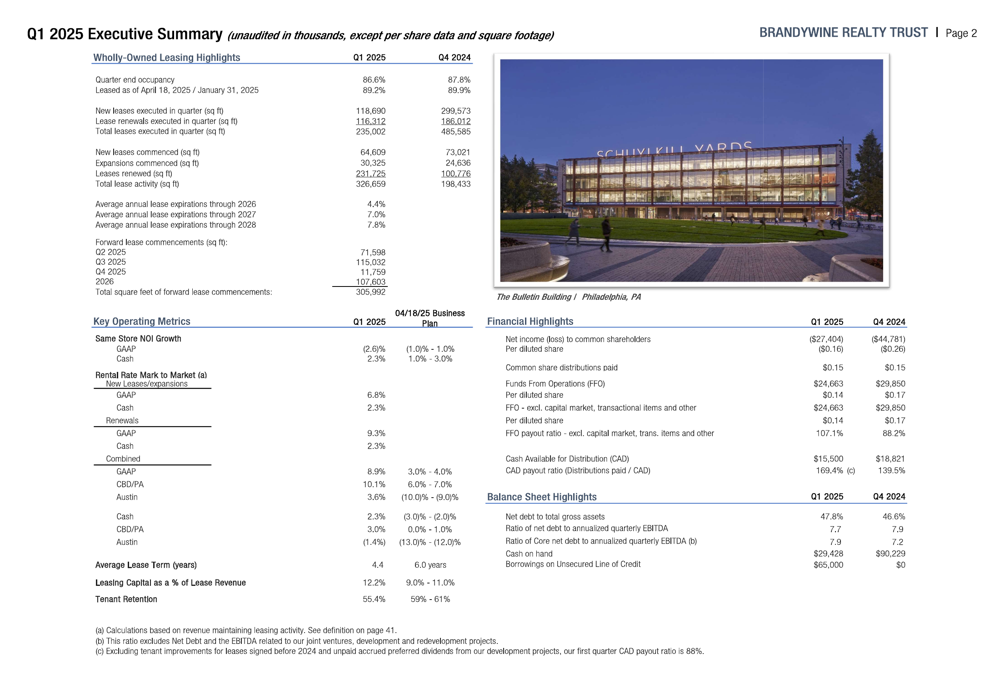
The company’s vacancy is primarily concentrated in seven properties that comprise approximately 50% of the total portfolio vacancy. These properties include Riverplace Buildings in Austin and 300 Delaware Avenue, highlighting the challenges in specific submarkets. Meanwhile, 41% of the company’s buildings are fully leased, demonstrating a quality bifurcation within the portfolio.
The following chart illustrates the concentration of vacancy across Brandywine’s wholly-owned portfolio:
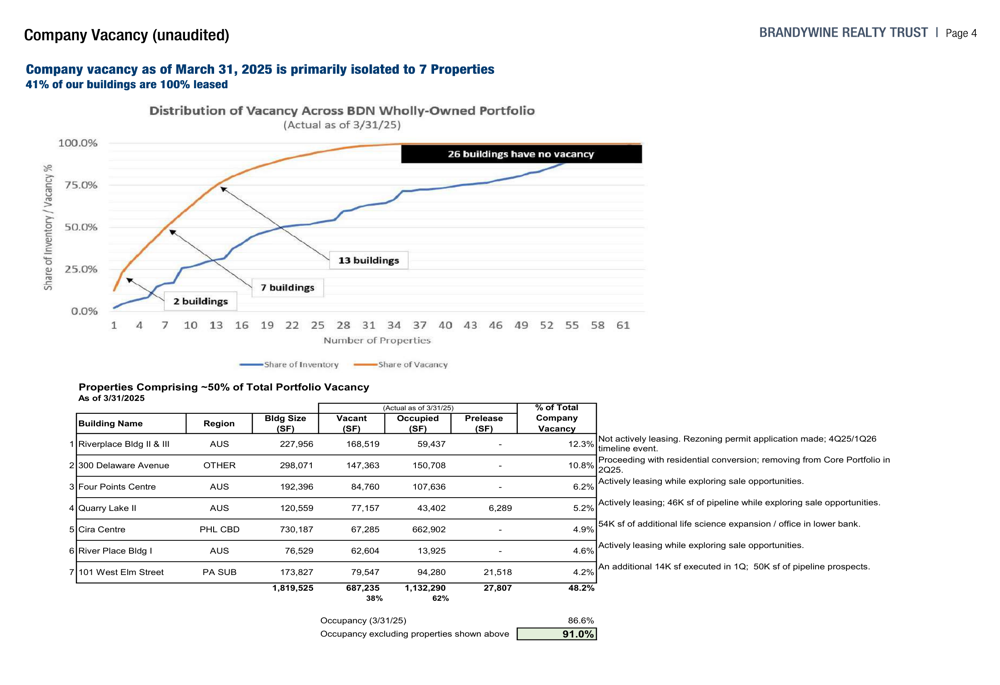
Strategic Initiatives
A key strategic initiative for Brandywine is its expansion into the life sciences sector. Currently, life science properties represent approximately 8% of the portfolio, but the company aims to increase this to 25% through organic growth via its existing land pipeline and convertible assets.
The life sciences market continues to show strength, with the FDA approving 55 novel drugs in 2023 and 50 in 2024. Life sciences venture capital funding reached $34 billion in 2024, exceeding 2023’s total of $30 billion. In Philadelphia specifically, life sciences companies raised nearly $1 billion in financing in 2024, and the region is home to 12% of cell and gene therapy companies worldwide.
The following illustration highlights Brandywine’s life sciences portfolio opportunity:
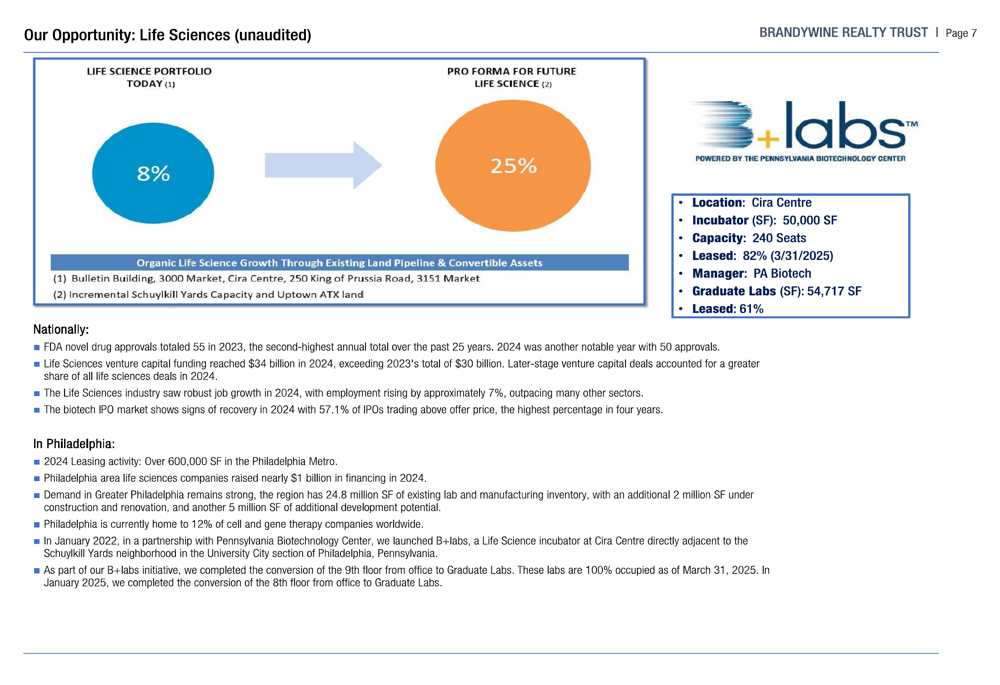
Development Pipeline
Brandywine’s development pipeline remains active, with several significant projects underway in both Philadelphia and Austin. In Philadelphia’s Schuylkill Yards neighborhood, the company is developing 3151 Market Street, a 316,909 square foot life science building scheduled for completion in Q4 2024, and 3025 JFK Boulevard, a mixed-use development featuring 200,000 square feet of life science/innovation office space and 326 residential units.
In Austin, the company is developing One Uptown, which includes a 362,679 square foot office building and a 341-unit multifamily project. The office component is 12% leased, while the residential portion has reached 56% leased as of April 18, 2025.
The following development summary provides details on these projects:

The company’s Uptown ATX development in Austin represents a significant long-term growth opportunity. This 66-acre transit-oriented community sits at the population center of Greater Austin and offers over 11 acres of park space. Based on the current development plan, Brandywine can develop 1.0 million square feet of office, 0.5 million square feet of life science, and 1,900 multi-family units with existing buildings remaining in place.
Similarly, in Philadelphia, the Schuylkill Yards development represents a multi-phase 14-acre/5.1 million square foot project focused on life science, research and academic facilities, office, residential, retail, and hospitality space.
Balance Sheet and Liquidity
Brandywine’s balance sheet shows a net debt to total gross assets ratio of 47.8% and a ratio of net debt to annualized quarterly EBITDA of 7.7x. The company had $29.4 million in cash on hand and $65 million in borrowings on its unsecured line of credit as of March 31, 2025.
For 2025, Brandywine has outlined a capital plan with $180 million in uses, including $80 million for dividends, $35 million for development/redevelopment projects, and $45 million for capital expenditures. Sources of capital include $95 million from cash flow after interest payments and $55 million from asset sales.
The following chart details the company’s 2025 capital plan and liquidity position:
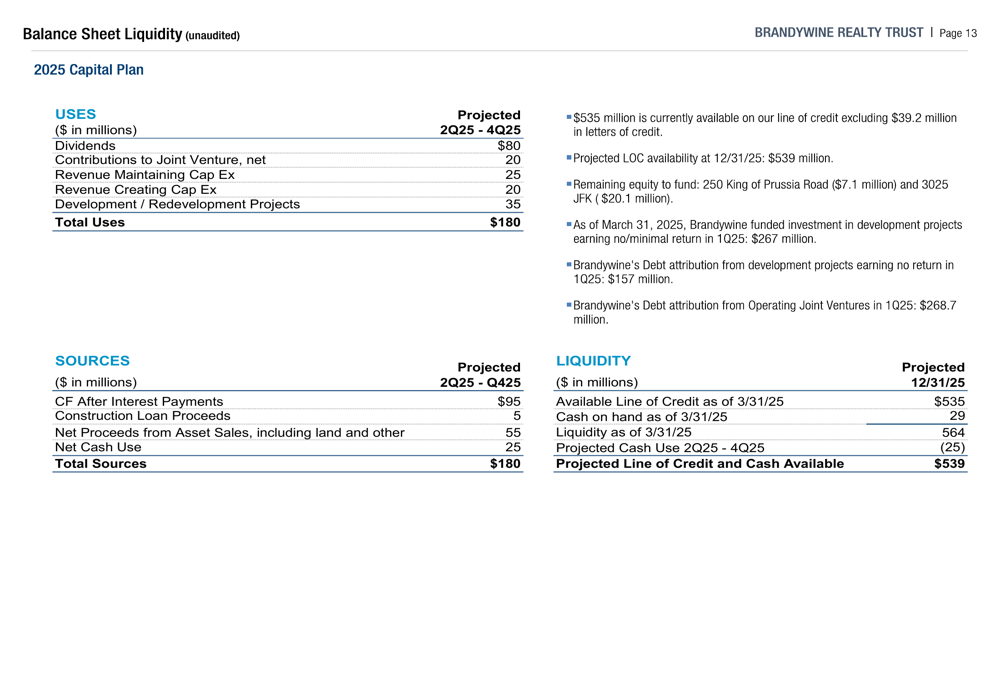
Brandywine’s land inventory represents a significant opportunity for future development. As of Q1 2025, the company owned 135.7 acres of land with an estimated development potential of 11 million square feet. This land is primarily located in Philadelphia’s CBD, Pennsylvania suburbs, and Austin, Texas.
The land inventory breakdown is illustrated in the following chart:
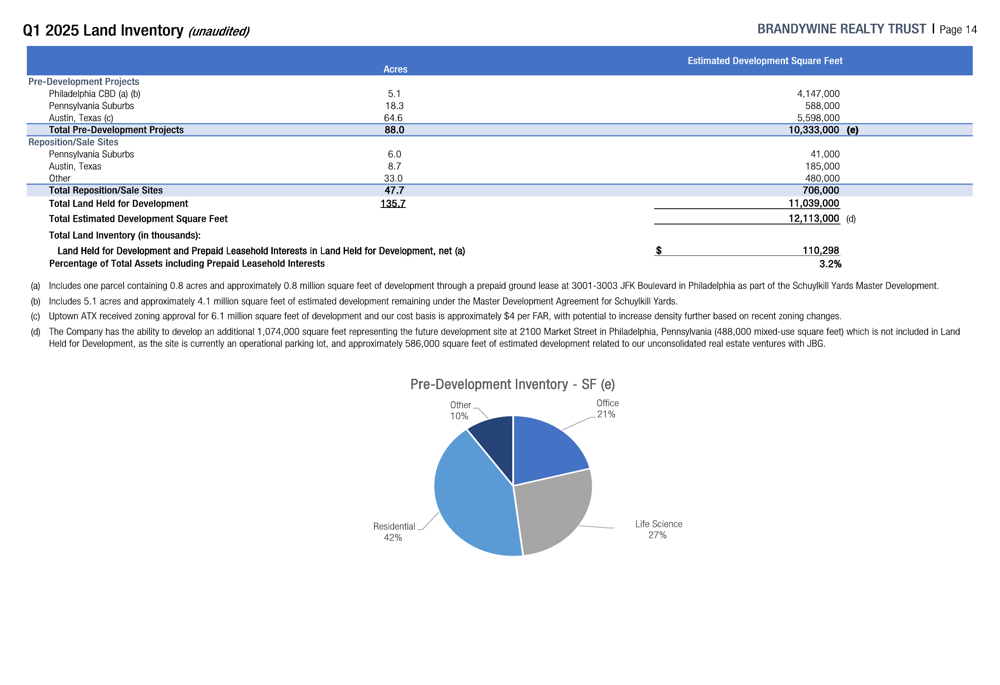
Market Positioning
Brandywine continues to benefit from strong market fundamentals in its core regions. In Austin, the company highlights the city’s position as the #1 best performing economy among top 50 metros over 5 years, with GDP growth of 39%. Austin added 22,700 jobs year-over-year, representing 1.7% growth, and ranks #1 for STEM jobs for the third consecutive year.
The following highlights from the Austin marketplace underscore the region’s strength:
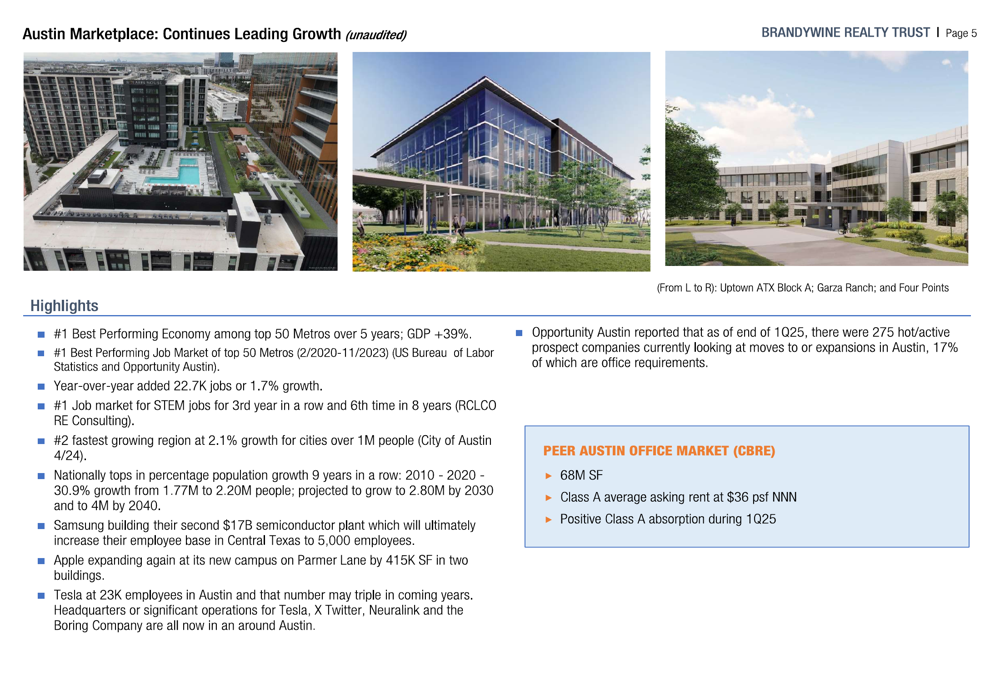
In Philadelphia, Brandywine emphasizes the city’s growing importance as a life sciences hub. The presentation notes that 80% of pharmaceutical and biotech companies in the U.S. have offices in Greater Philadelphia, and cell and gene therapy companies in Philadelphia secured $7 billion in private investment capital over the last five years. The city also benefits from a strong educational ecosystem, with 450,000 students attending institutions in the greater Philadelphia region.
Forward-Looking Statements
Looking ahead, Brandywine’s 2025 business plan projects same store NOI growth between -1.0% and 1.0% on a GAAP basis and between 1.0% and 3.0% on a cash basis. The company expects rental rate increases of 3.0% to 4.0% on a GAAP basis, though Austin is projected to see declines of 9.0% to 10.0%. Year-end same store occupancy is projected at 88-89%.
CEO Jerry Sweeney described 2025 as a "transitional earnings year" in the earnings call, emphasizing the company’s focus on project stabilization and NOI growth. The company maintains its dividend at 60 cents per share annually, representing a yield of approximately 15.42% based on current share prices, though the high CAD payout ratio of 169.4% raises questions about long-term sustainability.
Brandywine faces several challenges, including macroeconomic uncertainty affecting tenant decision-making, the high CAD payout ratio, and potential difficulties in asset monetization. However, the company’s strategic shift toward life sciences and mixed-use development, along with its strong positions in growing markets like Philadelphia and Austin, provide potential pathways for future growth.
Full presentation:
This article was generated with the support of AI and reviewed by an editor. For more information see our T&C.
